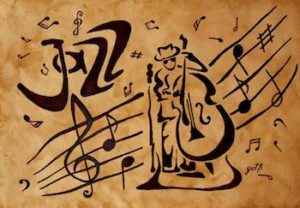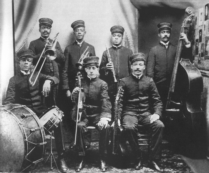Black History, and Jazz Music in America, a story

On this date, we focus on Jazz Music in America and the Black culture's role in creating and influencing its existence.
Jazz is an American musical form, often improvisational, developed by Blacks and influenced by European harmonic structure and African rhythmic intricacy. It is often characterized by its use of blues and speech intonations. Although it is not known exactly when jazz emerged, there were plantation brass bands as early as 1835, and minstrel troupes were touring by the 1840s. Ragtime, syncopated music that took its formal structure from the march, developed in the 1880s and is thought of as the forerunner of jazz.
Composed piano rags (music) by Scott Joplin and others achieved wide popularity at the close of the nineteenth century. (The "stride" style of pianists such as James P. Johnson and Fats Waller soon followed as an East Coast development of ragtime.) The earliest jazz band style developed in New Orleans, a city with a long, racially mixed cultural tradition. Starting in the late 1890s, Charles "Buddy" Bolden's band is thought to have played ragtime with improvised embellishments. By the turn of the century, many New Orleans bands were playing in a collective improvisational style. One of them was the Superior Band which included Bunk Johnson.
The Original Dixieland Jazz Band, a white group, copied Superior’s style and was the first to record (1917). Leading early 1920s groups included the New Orleans Rhythm Kings and the Jelly Roll Morton and King Oliver bands, whose music flowed more smoothly than ragtime. Jazz at this time included improvised solos, which in the playing of Louis Armstrong (trumpet) and others, led to the development of the Chicago style in the later 1920s. Larger ensembles started up often using written orchestrations. The style of jazz known as Swing was followed by groups led by Fletcher Henderson (with scores by Don Redman), Paul Whiteman (with Bix Beiderbecke), Chick Webb, Jimmie Lunceford, and Bennie Moten.
A regular rhythm and the contrasting sounds of the band sections characterize swing. Swing culminated in the music of groups led by Count Basie, Benny Goodman, Artie Shaw, and the Dorsey brothers. Through the activities of such men as Art Tatum (piano), Roy Eldridge (trumpet), and Lester Young (tenor saxophone), solo improvisation grew in influence during this period. Add to this the insertion of voice (in particular) Billie Holiday and Ella Fitzgerald, generally considered the greatest singers in the history of jazz. One of the most important late swing musicians was Duke Ellington, like Morton in the New Orleans style, shaped his musicians' improvisations on his original themes into strongly colored, finely balanced compositions.
The tradition of composing continued through later phases of jazz, in the work of Thelonious Monk, John Lewis, George Russell, and others. Bebop, or bop, was the first important postwar style. Its principal developers were Charlie Parker (alto saxophone) and John Birks "Dizzy" Gillespie (trumpet). Their improvisations on chord changes played against unpredictable accents and multifaceted cross-rhythms and had a new intensity. Cool jazz, some of which, like the playing of Stan Getz (tenor saxophone) and the ensembles of Cannonball Adderley (saxophone), arose from Lester Young's music, and developed partially as a reaction against bebop.
Other post-bop developments included the music of Lennie Tristano (piano), the Modern Jazz Quartet, Gil Evans, Miles Davis (trumpet), and others. A less formal type of group interaction was evident in such bands as those of Horace Silver and Art Blakey, together with a stronger emphasis on the blues and greater prominence for the drums in a music that was called hard bop. As jazz continued to evolve, inventiveness by Russell, Tristano, and Charles Mingus added even more variations of both rhythms and melody. Davis introduced modal jazz in his recording Kind of Blue (1959).
In the late 1950s and '60s, Ornette Coleman (alto saxophone), John Coltrane, Albert Ayler (tenor saxophone), and others developed a new emotional intensity in their playing, rejecting conventional jazz harmonies and melodies in favor of screeches, wails, and soaring cascades of notes played against irregular but driving rhythmic backups. This highly influential style became known as free jazz.

(The Superior Jazz Band, 1910)
In moving away from European influences, jazz attained by Don Cherry, Don Ellis, and others inserted fusions with the music of other cultures, especially the music of India and the Arab world. A counter tendency during the 1970s was the use of technology, particularly rhythmic ones, taken from rock. This led jazz musicians to experiment with electronic instruments. The most successful was Miles Davis' later bands, Weather Report, Return to Forever, and the Mahavishnu Orchestra. A different trend resulted in an unaccompanied improvisation by melody instruments.
The tradition of the free jazz of the 1960s was carried on by pianist Cecil Taylor and groups such as the Art Ensemble of Chicago into the 1980s. This techno-based jazz style is also called fusion; a popular form of music developed in the 1970s. Its main characteristics are drumming styles and instrumentation of rock music, going with improvisation with a strong emphasis on electronic instruments and dance rhythms. Although various jazz musicians began to include at least some jazz-rock in their performances and recordings no matter what their basic style, a few who made significant contributions before the 1970s also created original styles within jazz-rock as well, notably former Miles Davis associates pianist-composers Herbie Hancock, Chick Corea, and Joe Zawinul; saxophonist-composer Wayne Shorter; and guitarist John McLaughlin.
This style gained one of the largest jazz audiences since the swing era ended in the mid-1940s. As with swing-era big bands, those jazz-rock groups presenting the least improvisation tended to enjoy the most acclaim. The style was also known as "cross over" because music sales crossed from the jazz market to the popular music market. Jazz-rock provided a new musical vocabulary stemming in part from that offered by John Coltrane and sometimes from modern concert music and rock.
To this day, jazz remains ever-evolving, with tradition firmly established by composers, singers, and players who understand its history while embracing jazz’s base of continuous evolution. Some of those carrying the torch are Wynton Marsalis, Roy Hargrove, Terence Blanchard, Marcus Roberts, Bobby McFerrin, and others.
Jazz (as a cultural expression) has greatly influenced society. It remains on the outskirts of the public eye of contemporary American recognition and acceptance. This is consistent with its Black origins and mentoring.
Reference:
Jazz People
Published, 1976 by Harry N. Abrams
Library of Congress
ISBN 0-8109-1152-3
A Century of Jazz, by Roy Carr
Da Capo Press, New York
Copyright 1997
ISBN 0-306-80778-5
All That Jazz: The Illustrated Story of Jazz Music
General Editor: Ronald Atkins
Copyright 1996, Carlton Books Limited
ISBN 0-76519-953-X
New Poem Each Day
Poetry Corner

